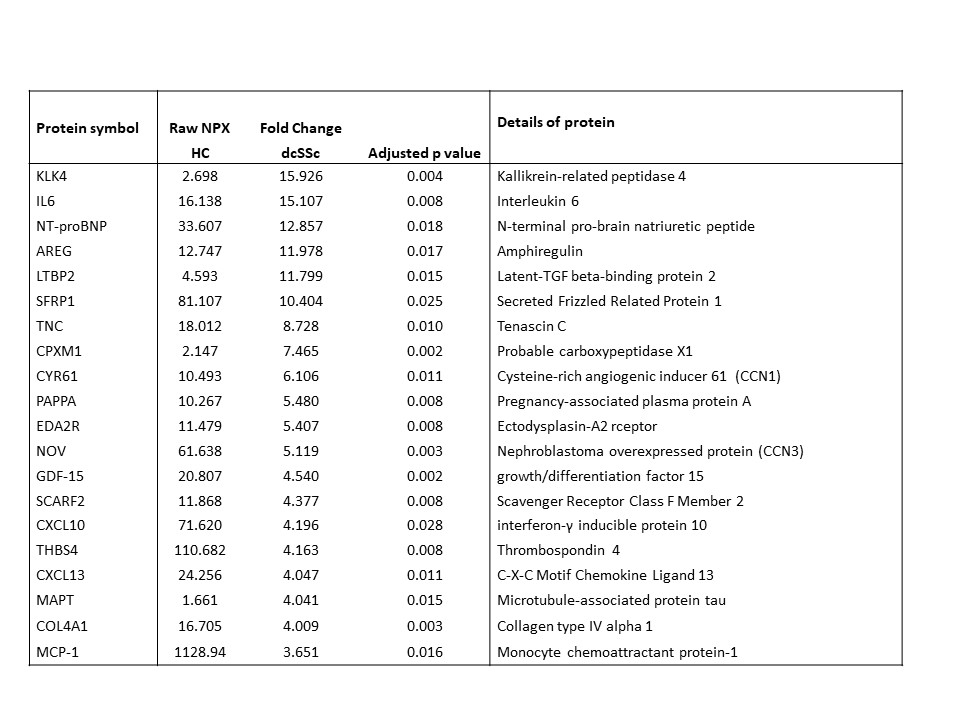Session Information
Session Type: Poster Session D
Session Time: 9:00AM-11:00AM
Background/Purpose: Simultaneous analysis of multiple proteins in biological fluids offers insight into the pathogenesis of SSc. Here, we report a proteomic analysis of plasma and dermal interstitial fluid in SSc compared with healthy controls (HC).
Methods: The prospectively collected BIOPSY cohort recruited 52 SSc patients (21 early dcSSc, 15 established dcSSc, 16 lcSSc) and 16 matched HC. 36 (69%) of the SSc patients are female. Mean baseline skin score (MRSS) for early dcSSc was 21 (sd 11.2). This analysis utilised forearm skin blister fluid obtained using the dermal suction blister method and paired simultaneous plasma samples from early dcSSc and HC at baseline. These were assayed using the Olink antibody platform with proximity extension assay (www.olink.com) and reported as normalized protein expression (NPX), corresponding to log2 (expression). T-test with FDR correction (p< 0.05) assessed statistical significance. Pathway analysis was conducted by STRING consortium 2020.
Results: 1196 proteins were analysed in paired blister/plasma samples from 14 early dcSSc patients and 16 HC. 447 proteins were significantly different in the blister fluid of early dcSSc patients compared with HC (see Table 1), whereas in plasma this was only 183 proteins. Of these, 130 proteins were simultaneously different in both blister fluid and plasma of early dcSSc including key cytokines associated with fibrosis and vasculopathy such as IL-6, VEGF-1, MCP-1, COL4A1, COMP, Thy1 and THBS4. No correlation was seen between any of these proteins and MRSS.
There were 310 proteins significantly elevated in blister fluid alone in early dcSSc patients compared to HC. These included cytokines (IL7, IL18, OSM), chemokines (CCL7, CCL18, CCL3), matricellular proteins (CYR61 and osteopontin). Pathway analysis using all significantly elevated proteins in blister fluid in early dcSSc compared to HV identified the top GO biological processes as immune system, response to stimulus, immune response and cell communication (FDR< 0.01). KEGG pathway analysis highlighted cytokine-cytokine receptor interaction, cell adhesion molecules, MAPK signalling pathway and the PI3K-AKT signalling pathway (FDR< 0.01).
Conclusion: Numerous dysregulated proteins were identified in dermal blister fluid and plasma of early dcSSc patients. Substantially more were identified in dermal blister fluid, highlighting the potential of this technique for providing detailed information on local pathologic processes. A subset of proteins were dysregulated in both plasma and blister fluid, suggesting these may reflect systemic abnormalities. Further work will utilise this cohort to integrate gene and protein expression across the full spectrum of early dcSSc, established dcSSc and lcSSc.
 Table 1: Top 20 most upregulated proteins in skin blister fluid for early dcSSc (n=14) compared with healthy control (HC, n=16)
Table 1: Top 20 most upregulated proteins in skin blister fluid for early dcSSc (n=14) compared with healthy control (HC, n=16)
To cite this abstract in AMA style:
Clark K, Campochiaro C, Csomor E, Taylor A, Nevin K, Morse M, Ong V, Derrett-Smith E, Wisniacki N, Flint S, Denton C. High-density Proteomic Analysis of Skin Blister Fluid and Plasma in Systemic Sclerosis Identifies Local and Systemic Differences for Key Proteins [abstract]. Arthritis Rheumatol. 2020; 72 (suppl 10). https://acrabstracts.org/abstract/high-density-proteomic-analysis-of-skin-blister-fluid-and-plasma-in-systemic-sclerosis-identifies-local-and-systemic-differences-for-key-proteins/. Accessed .« Back to ACR Convergence 2020
ACR Meeting Abstracts - https://acrabstracts.org/abstract/high-density-proteomic-analysis-of-skin-blister-fluid-and-plasma-in-systemic-sclerosis-identifies-local-and-systemic-differences-for-key-proteins/
